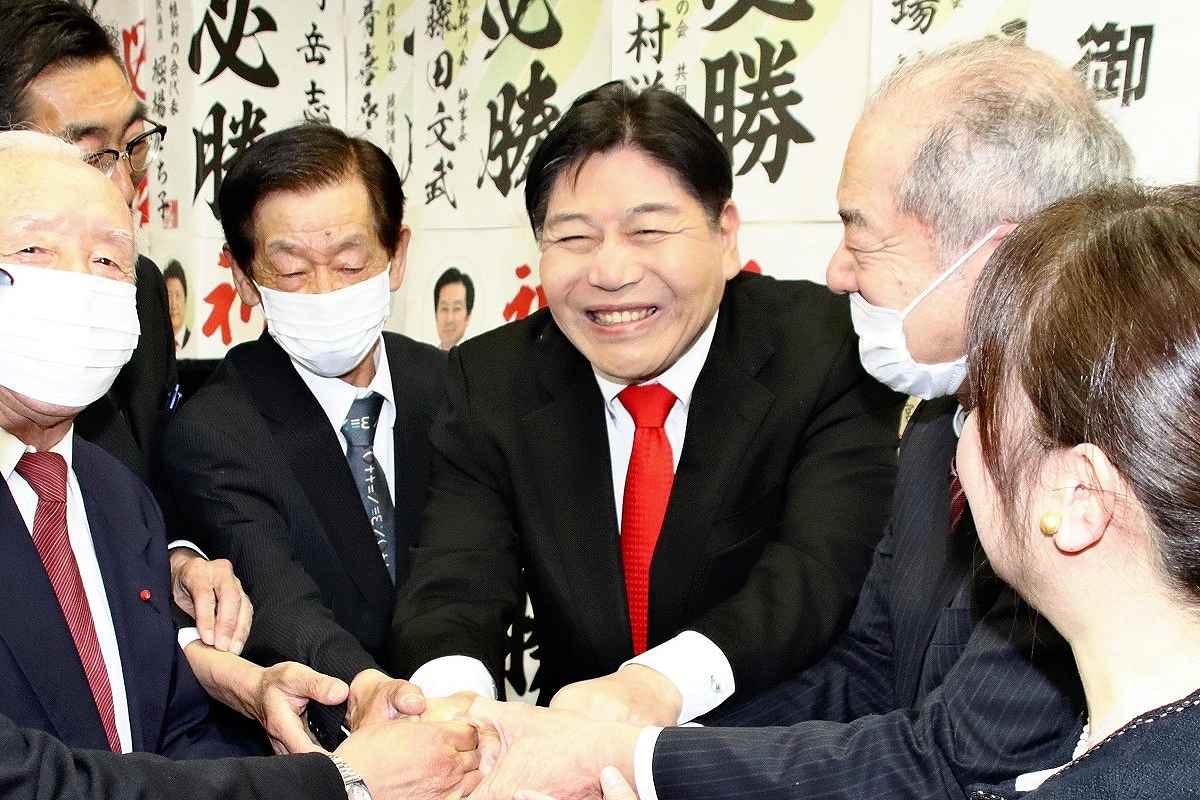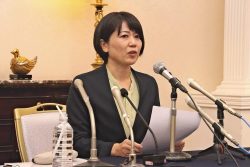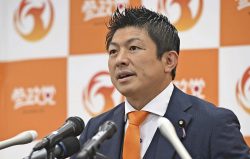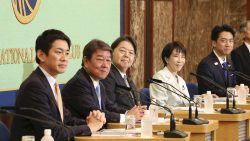
Takeshi Miyazaki, third from right, a candidate fielded by Nippon Ishin (Japan Innovation Party), shakes hands with supporters in Maebashi after winning a seat in the Gunma Prefectural Assembly election on Sunday.
18:33 JST, April 10, 2023
Nippon Ishin (Japan Innovation Party) has made a significant leap by securing 124 seats in prefectural assemblies after Sunday’s first half of the 20th unified local elections. The total, up from 67 seats in the previous first-half elections in 2019, includes seats won by its regional party, Osaka Ishin.
The results of assembly elections in 41 prefectures and 17 ordinance-designated cities showed a remarkable increase in the Ishin parties’ strength, prompting other parties to become wary of an Ishin wave in future elections, especially national ones.
In its home base of Osaka Prefecture, Ishin has already built a strong local organization centering on municipal government leaders, lawmakers and local assembly members. Ishin intends to focus on building such organizations beyond Osaka.
The Ishin parties retained their majority in the 79-seat Osaka Prefectural Assembly by winning 55 seats. In the 81-seat Osaka City Assembly, they secured a majority for the first time by winning 46 seats.
The unified local elections also included races to pick leaders of nine prefectures and six ordinance-designated cities, and Osaka Ishin easily won the polls for Osaka governor and mayor. Ishin also won in the Nara gubernatorial election, marking the first time for an Ishin candidate to become governor outside of Osaka.
While Ishin continues to demonstrate its popularity in its Kansai stronghold, its forces won prefectural assembly seats outside the region as well, including for the first time in Gunma and Tochigi in the Kanto region and Kagawa in Shikoku.

Yumi Okubo, who ran for the Tochigi Prefectural Assembly election as a candidate of Nippon Ishin (Japan Innovation Party), celebrates in Utsunomiya after her victory became certain on Sunday.
Some observers see Ishin as having gained footholds toward its long-cherished goal of becoming a truly national party that can influence the political situation across the nation.
“This is a significant step toward our goal of becoming a national political party,” Ishin Secretary General Fumitake Fujita said Monday.
In September 2022, Ishin marked the 10th anniversary of its establishment. The Ishin parties have set a goal of increasing their number of local assembly members to more than 600 over the two halves of the unified local elections. Ishin President Nobuyuki Baba has expressed his intention to step down from the post if this goal is not achieved.
The second half of the elections will be held April 23, and will include assembly elections in Tokyo and cities other than ordnance-designated ones.
LDP’s mixed results
The Liberal Democratic Party secured victories in the Hokkaido gubernatorial election, which was the only all-out confrontation between the ruling and opposition parties, as well as the Oita gubernatorial race, which became a de facto showdown between these two blocs.
However, the ruling LDP suffered a defeat in the Nara gubernatorial race due to a split in conservative votes caused by the party’s failure to coordinate on candidates.
“As well as steadily accepting the voices of encouragement and hope for the LDP and the ruling bloc, we must continue regaining our composure to deal with the situation,” Prime Minister Fumio Kishida, who is president of the LDP, said Monday morning.
Ishin’s advances have made some LDP members cautious. “While keeping a close eye on how they are expanding their strength, we must be thinking [about how to respond],” said Hiroshi Moriyama, chairperson of the LDP’s Election Strategy Committee.
Ishin’s Baba said his party has embraced the latest unified local elections as “an important election toward seizing the position of the main opposition party in the next House of Representatives election.”
The current main opposition, the Constitutional Democratic Party of Japan, is well aware of the situation.
“It is an objective fact that Ishin is gaining momentum,” Hiroshi Ogushi, chairperson of the CDPJ’s Election Strategy Committee said on Monday. “We will do our best to increase our seats.”
Komeito, the LDP’s ruling coalition partner, had set a goal of having all 342 candidates it fielded — 170 candidates in prefectural assembly elections and 172 candidates in ordinance-designated city assembly races — elected, but failed to achieve this goal with its candidates defeated in the Aichi prefectural and Osaka city assembly elections.
Komeito still had 169 seats in prefectural assemblies and 171 in the ordinance-designated city assemblies. For every unified local election, Komeito pledges that all its candidates will win but has not been able to do so since 2007.
The CDPJ failed to show its presence in the first half of the elections as the party suffered setbacks such as in the Hokkaido gubernatorial election. The party failed to field candidates aggressively in the nine gubernatorial races, exposing the weakness of its electoral base despite being the largest opposition party.
The percentage of seats won by the LDP in the 41 prefectural assembly elections, in which a total of 2,260 were contested, was 51% (1,153 seats), almost the same level seen in the previous first-half unified elections when the figure was 50.9%.
The LDP scored a majority of these assembly seats for the third consecutive time, having done so following the previous two elections in 2015 and 2019.
Record highs, lows
A record high 316 women were elected in Sunday’s elections, a significant increase from the previous record high of 237 in the first half of the unified elections in 2019.
Average voter turnout in the 41 prefectural assembly elections hit a record low of 41.85%, down 2.17 percentage points from the previous record low in the last unified elections in 2019, according to the Internal Affairs and Communications Ministry. For the nine prefectural gubernatorial races, the average voter turnout was also a record low at 46.78%. The previous record low of 47.14% was set in 2015, when there were 10 such races.
"Politics" POPULAR ARTICLE
-

Japan to Support Central Asian Logistics Route That Bypasses Russia, Plan to Be Part of Upcoming Summit in Tokyo
-

Japan to Tighten Screening of Foreigners’ Residential Status by Providing Information of Nonpayment of Taxes
-

Chinese, Russian Bombers Flew Unusual Path by Heading Toward Tokyo; Move Likely Meant to Intimidate Japan
-

Japan Plans National Database to Track Foreign Ownership of Real Estate, Land as It Weighs New Rules
-

Up to 199,000 Deaths Estimated From Mega-Tsunami; Most Recent Occurrence Took Place in 17th Century
JN ACCESS RANKING
-

Tokyo Economic Security Forum to Hold Inaugural Meeting Amid Tense Global Environment
-

Keidanren Chairman Yoshinobu Tsutsui Visits Kashiwazaki-Kariwa Nuclear Power Plant; Inspects New Emergency Safety System
-

Imports of Rare Earths from China Facing Delays, May Be Caused by Deterioration of Japan-China Relations
-

University of Tokyo Professor Discusses Japanese Economic Security in Interview Ahead of Forum
-

Japan Pulls out of Vietnam Nuclear Project, Complicating Hanoi’s Power Plans



























